How to Clean and Prepare Your Catch: Step-by-Step Guide

Gather Your Cleaning Supplies Before Starting
Before you dive into cleaning your catch, it’s crucial to gather all necessary supplies. You’ll need a sharp knife, a cutting board, and a bucket for waste. Having a pair of gloves handy can also make the process more hygienic and comfortable.
The fishing was good; it was the catching that was bad.
Consider having a cooler or ice on hand to keep your catch fresh while you work. If you're fishing in a remote area, a portable cleaning station can help streamline the process. Preparation is key to ensuring a smooth experience.
Lastly, make sure you have access to fresh water for rinsing. Having everything ready allows you to focus on the task at hand and ensures that your catch is cleaned properly, maintaining its quality.
Choose a Clean and Safe Location for Cleaning
Finding the right spot to clean your fish is essential for both safety and hygiene. Look for a flat, clean surface that’s easy to maintain, such as a picnic table or a designated cleaning station.

Avoid cleaning your catch near where you’ve set up camp or where food is prepared. This reduces the risk of contamination and keeps everything organized. If you’re at a public area, ensure that the location abides by any rules regarding cleaning fish.
Gather Supplies for Efficient Cleaning
Having all your cleaning supplies ready, including a sharp knife, cutting board, and fresh water, ensures a smooth and hygienic fish cleaning process.
Additionally, consider the weather and your comfort. A shady area can prevent the sun from spoiling your catch while you work. Choosing the right location sets the tone for a successful cleaning experience.
Start by Scaling or Removing Fish Skin
Once you have your catch in the right spot, it’s time to scale or skin it. If you're dealing with a fish that has scales, use the back of your knife to scrape them off, starting at the tail and moving towards the head. This process can be a bit messy, so be prepared!
The best way to enjoy your catch is to make sure it’s fresh and cooked properly.
For fish that are skinned, make a small incision near the tail and peel the skin away with your hands or knife. Removing the skin can enhance the flavor and texture of your dish. Just make sure to work gently to avoid tearing the flesh.
Scaling or skinning is an essential step to ensure your meal is delicious. It also helps in the overall presentation of the fish when you cook it later.
Gut the Fish Properly for Freshness
Gutting your fish is a crucial step to ensure freshness and quality. Start by making a small incision along the belly from the tail to the head, taking care not to cut too deep and damage the organs. This will help prevent any bitter taste from the entrails.
Once you’ve made the incision, use your fingers or a spoon to carefully remove the internal organs. It’s important to be thorough and clean out all the insides to prevent spoilage. Remember, the quicker you do this after catching the fish, the fresher it will taste.
Properly Gut for Freshness
Gutting your fish promptly and correctly is essential to maintain its freshness and prevent any undesirable flavors.
Gutting may seem daunting at first, but with practice, it becomes second nature. Plus, knowing how to properly gut your catch ensures that you’re making the most of your hard work out on the water.
Rinse the Fish Thoroughly After Gutting
After gutting, it’s essential to give your fish a thorough rinse. This helps remove any remaining blood, slime, or debris that could affect the flavor. Rinsing not only enhances taste but also promotes hygiene.
Using fresh, clean water, gently rinse both the inside and outside of the fish. Make sure to do this away from any contaminants to keep your catch clean. A quick rinse can make a world of difference in the quality of your meal.
Once rinsed, pat the fish dry with a clean cloth or paper towel. This step helps prepare it for cooking and ensures the best flavor when you’re ready to enjoy your catch.
Cut the Fish Into Fillets or Steaks
Now that your fish is cleaned and rinsed, it’s time to cut it into manageable pieces. Depending on your cooking method, you may want to create fillets or steaks. A fillet is a boneless piece of fish, while a steak includes the bone, often from larger species.
To fillet, hold the fish steady and use a sharp knife to slice along the backbone, working your way down to the rib cage. For steaks, cut crosswise into thick slices. The choice between fillets and steaks often comes down to personal preference and the type of dish you plan to create.
Store Cleaned Fish for Best Quality
Correctly storing your cleaned fish in ice or vacuum-sealed packaging keeps it fresh and delicious until you're ready to cook.
Cutting your fish properly not only makes for easier cooking but also enhances presentation on the plate. This is where your catch begins to transform into a delicious meal!
Store Your Cleaned Fish for Optimal Freshness
After cleaning and cutting your fish, proper storage is key to maintaining freshness. If you're not cooking it right away, place the fish in a cooler packed with ice. This keeps the fish at a safe temperature and prevents spoilage.
You can also wrap individual fillets in plastic wrap or aluminum foil to keep them moist. If you plan to store them longer, consider vacuum sealing. This method removes air and helps prevent freezer burn, preserving the fish's quality.

Taking the time to store your catch properly ensures that it will be just as delicious when you’re ready to eat it. Freshness is essential for getting the most out of your hard work.
Enjoy Your Catch: Cooking and Serving Tips
Now that you’ve cleaned and prepared your catch, it’s time to enjoy it! Whether you prefer grilling, baking, or frying, there are countless ways to bring out the flavor of your fish. Simple seasonings like lemon, herbs, and spices can elevate your dish.
Consider serving your fish with sides that complement its flavor, like fresh vegetables or grains. A well-prepared meal can make all the effort worthwhile and create lasting memories with friends and family.
Cooking your catch not only rewards your hard work but also connects you to the experience of fishing. So go ahead, savor your delicious meal and relish the satisfaction of enjoying something you’ve caught yourself.